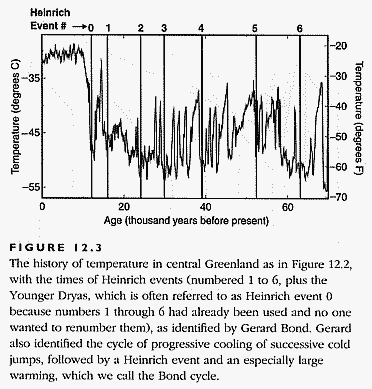

2004 Aug
This book documents the findings of ice core projects in Greenland:
Greenland Ice Sheet Project (GISP) Danish-Swiss-US, 1981
Greenland Ice Core Project (GRIP) European, 1989-1992
Greenland Ice Sheet Project 2 (GISP2) US, 1989-1993
Central Greenland is chosen because the ice there tends to accumulate (since it is the middle of the island) rather than flow.
Climate changes are deduced from:
The book tells the story of how many of these indicators support each other. Researchers from around the planet have been turning up data from their specialties to provide further detail and certainty about the climate record.
Major conclusions (quoted):
Major results:
Earth's orbit has an eccentricity with a 100,000-year cycle, causing it to go from elliptical to circular. In addition, the axis of rotation tilts on a 41,000-year cycle, and wobbles on a 19,000- to 23,000-year cycle. These orbital changes affect the amount of sunlight received by the earth, and more importantly for climate, where the sunlight hits (north or south hemisphere). Sunlight variations don't translate directly to ice because of non-linearities -- for example, it takes longer to form an ice sheet than to melt one, because a larger ice sheet has a warmer bed, has a warmer surface, and can flow faster (into warm water around it). Here's the history of ice in the last 800,000 years, based on oxygen isotope variations in shells in ocean sediments:

Ice ages are associated with reduced carbon dioxide. The best guess is that stronger winds during ice ages (see next chart) cause more dust to fertilize algae in the ocean, absorbing CO2, reducing greenhouse effect, causing more ice.

Wind increased in Venezuela during colder periods -- winds carry dust that fertilize ocean algae, absorbing CO2:

(Winds there mix water, bringing nutrients to the surface to fertilize plankton, which make shells that color the sediment white -- the graph is of sediment color.)
Rocks are dropped in the north Altantic by melting icebergs. There are patterns over time of the droppings, finally explained as 'Heinrich events'. A Heinrich event occurs when an ice sheet covering Hudson's Bay gets so thick that the earth's heat starts melting its base, cause the Hudson Bay ice sheet to suddenly skate out into the Arctic and north Altantic oceans -- causing a big influx of fresh meltwater.
[It's interesting how the arrangement of the continents has such an impact. The role of Hudson Bay is astonishing! It reminds me of tidal action in the Bay of Fundy (an oscillation cavity).]

'Bond cycles' (related to changes in Gulf Stream circulation) lead up to a Heinrich event:

Heat is carried by the Gulf Stream into the far north. However, if there is enough fresh water in the north Atlantic, the salty Gulf Stream can sink prior to reaching the north. This has a major cooling effect that show up as Bond cycles. The ice core record shows that the Gulf Stream can switch modes abruptly. These switches are thought to be responsible for the 'Dansgaard-Oeschger cycles' (abrupt switching between warm and cold) observed in the ice cores.

Recent history:

The 'dryas' is a rose-like flower that grows today only in alpine regions. However, its pollen is found in layers of low-lying European forest bogs, indicating that at the time it was much colder. Three periods of dryas pollen have been noted in the bog records, and are called the Younger, Older, and Oldest Dryas periods. Radiocarbon dating of the layers sets their dates, which match other yardsticks, eg., ice cores, wind in Venezuela. "During the Younger Dryas, the north Pacific cooled, glaciers advanced from high peaks in NZ and the Andes, and lakes in Africa shrank as the Sahara Desert spread into former fertile regions".
[The end of the Younger Dryas seems to correspond to the end of the large mammals in North America. Climate change may have had a lot to do with that extinction, not just humans (who were expanding into N.America during that time).]
Recent history in a larger context:

Alley's conclusions:
Of life decisions a person faces, the decision with probably the most consequence to the environment is whether or not to produce a child.
Subsequent developments (2004):